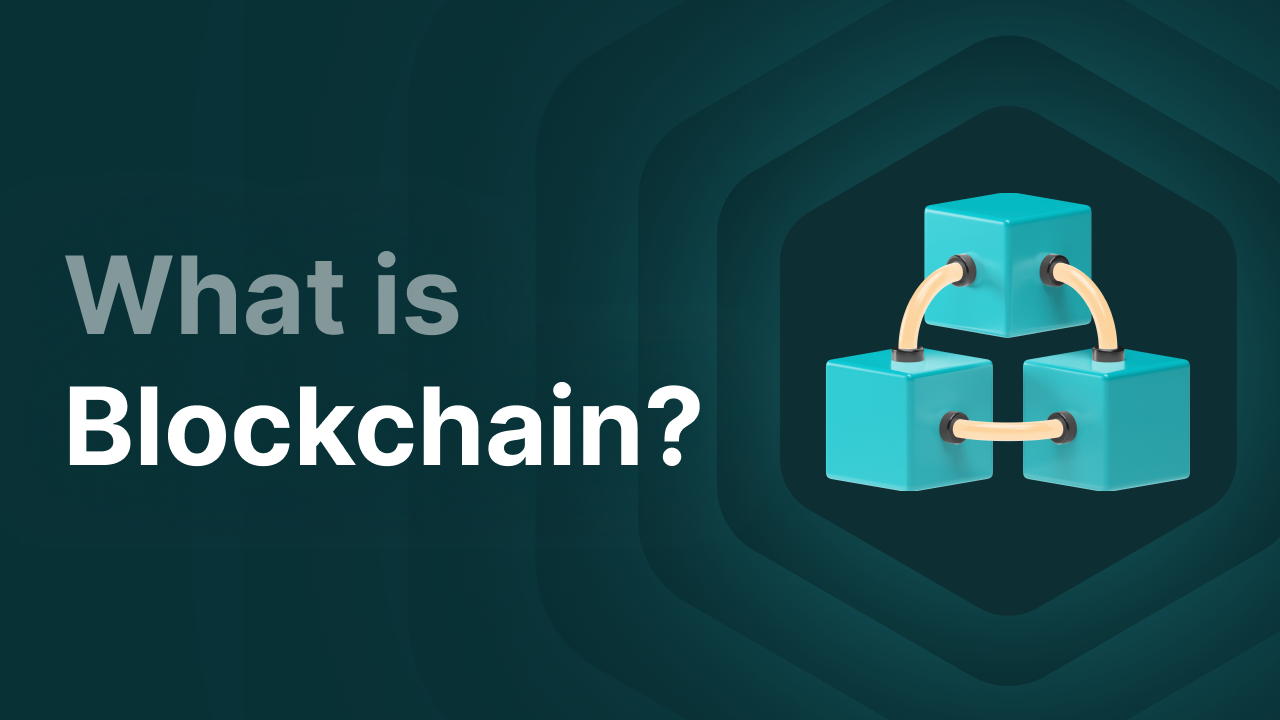What Is a Blockchain and How Does It Work?

What Is a Blockchain?
A blockchain is a digital database, also called a “public ledger,” where transactions are stored. Most blockchains are public, open-source, and run on a network of computers around the world. That makes them decentralized, meaning no single party is in charge.
The blockchain is made up of blocks that contain transactions. Each new block connects to the previous one, forming a chain, the blockchain. A new block includes the latest transactions and refers back to the previous block. Once the network agrees everything checks out, the block gets added.
Once data is on the blockchain, it stays there. You can’t go back and change or delete it.
Example: Imagine the blockchain is like an anchor chain. Each block is a link that holds transaction data. If you follow the chain down, you can see every transaction that’s ever happened. So everything is transparent. And if someone tries to fake something, the network will catch it and reject it. That’s why blockchains are so trustworthy and secure.
Key Takeaways
- A blockchain is a decentralized and unchangeable digital ledger where transactions are stored in cryptographically linked blocks.
- Cryptocurrencies run on blockchains and use this technology for transactions and security.
- Transactions are verified through consensus mechanisms like Proof of Work (PoW) or Proof of Stake (PoS).
- The tech offers strong security thanks to cryptography, decentralization, transparency, and immutability.
- Pros: secure, transparent, open. Cons: energy use, scaling challenges.
Are Cryptocurrencies the Same as Blockchains?
Not exactly. Cryptocurrencies like BTC or Ether are digital coins that run on a blockchain, such as the Bitcoin or Ethereum network. The blockchain manages the coins, but it’s the system behind them, not the coins themselves.
For example, if you send BTC, the network verifies that transaction and permanently stores it on the blockchain.
How Does a Blockchain Work?
The blockchain is basically a shared ledger that lives on tons of computers, called nodes. Every transaction gets recorded securely, transparently, and permanently. Here’s how it works, step by step:
1. A Transaction Is Created
Let’s say you want to send Bitcoin. You open your wallet, enter the recipient’s address, the amount, and maybe some extra info, like a memo. You’ll also pay a small fee, which goes to the nodes that process the transaction.
2. The Transaction Enters the Network
Your transaction gets broadcast to the entire peer-to-peer network. Every node sees the same info.
3. The Transaction Gets Verified
Now the nodes check if the transaction is legit. The method depends on the consensus mechanism. The two most popular ones:
- Proof of Work (PoW): Computers solve complex puzzles, used by Bitcoin.
- Proof of Stake (PoS): Validators lock up coins as collateral to confirm transactions, used by Ethereum and Cardano. More energy-efficient than PoW.
4. Transactions Go into a Block
Once verified, the transactions get grouped into a new block. A node, either a miner in PoW or a validator in PoS, puts the block together.
5. The Block Gets Added to the Chain
The new block contains a reference to the previous block’s hash, linking the chain together. Once added, the block is locked in for good. You can’t go back and change it.
6. The Network Confirms It
Once the block is added, the updated blockchain gets shared with all the nodes. They all update their copy. Once your transaction is in a confirmed block, it’s considered complete.
Example: Say you want to send a letter to a friend. You write the letter, put it in an envelope, and add your return address (your wallet address) and their address (recipient). Then you drop it off at the post office, the network. The postal workers, the nodes, check if the letter’s legit. If everything looks good, it gets accepted.
Your letter goes into a mailbag with other verified letters, a block of transactions. That bag gets labeled, maybe Block #840,000, so later on you can see what was sent and when.
Once it’s delivered, it’s official, the letter was sent. Nobody can deny it or change what it said.
What’s the Biggest Advantage of a Blockchain?
Probably the biggest advantage is that you don’t need a middleman, no bank or central authority. You can interact or transact directly with others.
Why Is Blockchain So Secure?
Blockchains are considered very secure for several reasons:
1. Cryptography
All data is stored using encryption. Cryptographic techniques ensure that only users with the right keys can read or send data. Every transaction has to be digitally signed. Each block also gets a unique hash that locks in its content.
If someone tries to change anything, the hash changes and the network notices immediately. That’s what makes blockchains so tamper-proof.
2. The Chain of Blocks
If a hacker tries to change one block, they’d also have to change all the blocks that come after it. On big networks with thousands of nodes, that’s practically impossible.
3. Decentralization
There’s no single point of control. The data is stored across tons of nodes around the world. Each node has the same version. For a transaction to go through, multiple nodes have to agree it’s valid.
4. Consensus Mechanisms
New blocks only get added if the network reaches consensus. Usually over 50% of nodes have to agree. That keeps fake or malicious blocks out. If someone wanted to cheat the system, they’d have to control more than 50% of the nodes, a “51% attack,” which is very hard to pull off.
5. Transparency
Most public blockchains are open-source. Anyone can view the code and all transactions. With blockchain explorers, you can track everything in detail.
6. Immutability
Once something’s written to the blockchain, it stays there. You can’t change or delete it. The only way to alter anything is if the whole network agrees, like with a hard fork. That’s what happened with Ethereum after the DAO hack. The network split into Ethereum, the new chain, and Ethereum Classic, the original one.
What kinds of blockchains are there?
There are a few different types of blockchains developers can work with, public blockchains, semi-private blockchains, private blockchains, and consortium blockchains:
-
Public blockchains
This is the kind of blockchain most people know. All the big names like Bitcoin and Ethereum use this type. Anyone can view the data on the blockchain and join the network without needing permission, and without giving up their anonymity. Public blockchains are totally open and decentralized, meaning no central authority controls them. -
Semi-private blockchains
These are run by a single company or organization, so they’re more centralized than public ones. That organization gets to decide who can join and who can't. It’s not fully open, but it does give controlled access to specific users. These blockchains are often used by companies or governments that need a little more control. -
Private blockchains
In this case, everything is fully centralized. One party controls the whole thing, reading the data, doing transactions, and managing access to the network. These aren’t great for situations that need transparency or decentralization, but they can work well for businesses that need a closed, secure system. -
Consortium blockchains
This one is super popular with businesses. Instead of just one company running the show, a group of organizations shares control. They decide who gets to approve transactions and see the data. Consortium blockchains are great for business and institutional use cases where teamwork, control, and privacy matter.
Energy usage of blockchain tech
Blockchain energy use is a hot topic. Cryptos like Bitcoin often get criticized for using tons of electricity and being bad for the environment. That’s because Bitcoin, and others like Dogecoin, use something called Proof-of-Work. Basically, computers all over the world race to solve hard math problems, which takes a lot of power. That process is called mining. Some reports even say Bitcoin uses as much electricity as an entire country, like Poland.
Because of this, newer blockchains are switching to Proof-of-Stake. Instead of solving puzzles, people lock up some of their crypto as collateral, and that’s how they get to validate transactions. This uses way less computing power and electricity. Ethereum and Cardano are good examples of this.
Blockchain scalability
Scalability is all about how quickly a blockchain can handle lots of transactions, safely and efficiently. The busier it gets, the more stressed the network becomes. That’s why blockchains like Bitcoin and Ethereum get slammed during peak times. Since every transaction has to be validated by the whole network, things can slow down a lot. You end up waiting longer and paying higher fees.
Bitcoin was designed to be an alternative to traditional finance, so this is kind of a big issue. It can only handle around 7 transactions per second, compared to Visa, which does thousands.
To fix this, developers have come up with a few solutions, like ways to make Bitcoin and Ethereum scale better, and even new blockchains that are scalable by design:
- Layer 2 solutions, like the Bitcoin Lightning Network, let transactions happen off the main chain and then batch them together for validation.
- Sharding breaks the blockchain into smaller pieces that can work in parallel, speeding things up a lot.
- New consensus methods, like Solana’s Proof of History or advanced Proof-of-Stake systems like Avalanche.
Pros and cons of blockchain tech
Blockchains have some awesome benefits and a few downsides too. Here’s a quick breakdown:
| Pros | Cons |
|---|---|
| Decentralized: No single person or group is in charge. It’s all run by thousands of nodes worldwide. | Energy use: Networks like Bitcoin suck up a ton of electricity due to Proof-of-Work. |
| Transparent: Everyone can see the transactions, so it’s super hard to cheat the system. | Scalability issues: As blockchains get more popular, they can get slow and expensive. |
| Secure: Data is encrypted and really tough to mess with. | Irreversible: You can’t just undo a transaction if there’s fraud or a mistake. In serious cases, a hard fork might be needed. |
| Accessible: Anyone with internet can join the network. | – |
Who invented blockchain?
A lot of people think blockchain started with Bitcoin and Satoshi Nakamoto. While Satoshi definitely helped make it big, the idea itself goes back further.
In 1983, computer scientist David Chaum came up with “blind signatures,” a way to sign data without actually seeing it. That was the first step toward anonymous digital transactions.
In 1991, mathematicians Stuart Haber and W. Scott Stornetta created a method to timestamp digital files so they couldn’t be secretly changed later. A year later, they added a data structure that chained documents together, basically the first version of a blockchain.
But it wasn’t until 2008 that blockchain really hit the spotlight. Satoshi Nakamoto published the Bitcoin whitepaper and used blockchain tech to create a public, decentralized way to send digital money. No banks needed. That was huge because it mixed cryptography, economics, and tech into a working system.
So no, Satoshi didn’t invent blockchain, but he did build the modern version we use today in crypto.
Final thoughts
Blockchain is a cool way to store data securely, transparently, and without needing a central authority. It uses cryptography, decentralization, and consensus mechanisms to build trust in networks. Sure, there are challenges like energy use and scaling issues, but the potential is massive, both for finance and beyond. And as new and better validation methods keep popping up, the tech just keeps evolving.
